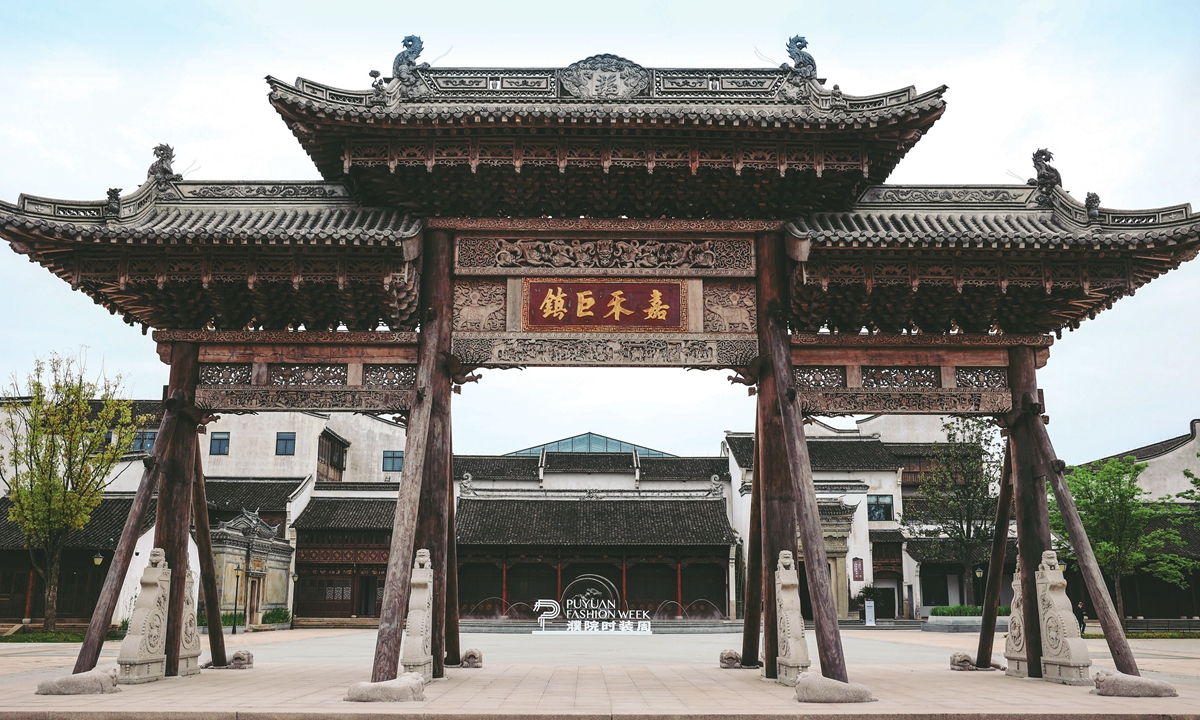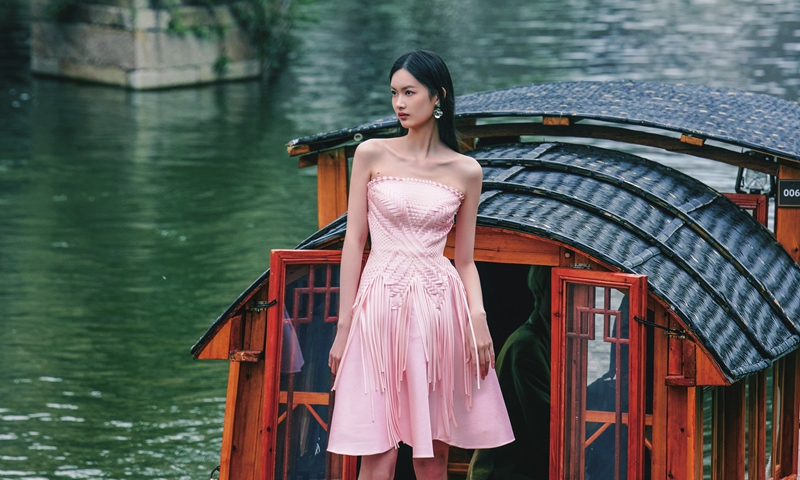ARTS / ART
Puyuan fashion week injects intangible cultural heritage art with new vitality
A better inheritance

Puyuan town in Tongxiang city, East China's Zhejiang Province Photo: Courtesy of Puyuan fashion week

A model wears collections designed by Grace Chen. Photo: Courtesy of Grace Chen
The Puyuan fashion week, a week-long fashion feast, has kicked off in the hometown of Pu silk - Puyuan town in Tongxiang city, East China's Zhejiang Province on Monday.
A total of six local fashion brands and 14 international brands have participated in the fashion week with various themed fashion shows in the Puyuan Fashion Town, a newly opened tourism hot spot that connects fashion, life and aesthetics. Two of the highlight shows titled with "Cangcuixie" and "Qinghuanji" or "Simply Joy," were full of Chinese elements and have displayed intangible cultural heritage art.
An ancient craftsmanship
Feng Jiyan, one inheritor of Pu silk and head of the "Cangcuixie" show, told the Global Times that the over 20 suits displayed during the fashion week are made with nine traditional colors of Pu silk and matched with different geometric patterns.
He explained that the color "cang" and "cui" in Chinese is actually a mix of black and green, which was the most popular color in Song Dynasty (960-1279).
Media reported that Pu silk is one of the four famed silks in China's Jiangnan, the region south of the Yangtze River. It has a long history and a beautiful legend which tells that Xi Shi, one of the renowned Four Beauties of ancient China, once lived in Tongxiang with her lover Fan Li, and they co-opened a silk shop to produce the Pu silk.
Pu silk features exquisite weaving, fine texture, soft, smooth colors and is also very tough and durable. Thanks to these advantages, the silk was used by royals during the Southern Song Dynasty (1127-1279) and was sold to European markets through the ancient silk road that passed through today's Northwest China's Xinjiang Uygur Autonomous Region and through the Maritime Silk Road that passed today's Quanzhou in East China's Fujian Province.
According to Feng, Pu silk is three times tougher than ordinary silk. Its wear-resisting characteristic is mainly due to the soaking in water at different temperatures, and the raw material used for dyeing is an ancient plant native to Tongxiang city.
Currently, Feng is helping to launch a new standard to optimize the production by using some more advanced machines, while still keeping the traditional craftsmanship of Pu silk.
He pointed out that making a cloth made of Pu silk usually takes an average of two to three months due to the complicated making process of the silk, meanwhile the embroidery process may take 2-3 days.
"A good inheritance should not totally obey the original routine. Instead, we need to show respect, fully understand it and keep its essence intact, while bestowing some new creativity into it. Only in this way can the intangible cultural heritage art be kept alive," he said and added that Pu silk in fact originated from the Spring and Autumn Period (770BC-476BC) and the reason why it flourished and can now be passed on is the creativity of our Chinese ancestors.
Having engaged with the inheritance of Pu silk for over 10 years, Feng, who is in his 50s, said he was pleased to see more young Chinese show interest in the traditional craftsmanship and he is currently teaching many young apprentices who plan to take this traditional skill as their career.
"I see interest from the young and they also motivate me to lead the road further on," he said.
Classic fashion to lead world
Another show that was full of traditional Chinese elements was "Simply Joy" GRACE CHEN 2023 Chinese Classic Literature Surrealism Collection,the closing show of the fashion week from the famed Chinese American designer Grace Chen.
The show was characterized by classical Chinese poems and literature works, aiming to convey Confucianism, positivity and elegance from the Chinese ancestors.
"Fashion is a kind of attitude toward life and it can show a person's temperament," Chen told the Global Times.
Chen once used many elements of intangible cultural heritage art into her brand, including Suzhou embroidery, Miao embroidery - a Miao costume traditionally embroidered with tin wires - and Chinese knots, but at the same time, she would make innovations to make the clothes she designed more practical .
"Instead of putting it [traditional craftsmanship] in a museum, the traditional craftsmanship should keep up with the times and be injected with new vitality so that the customers can feel the spirit of traditional Chinese culture while also enjoying contemporary aesthetics," she said.
As an experienced fashion designer educated both in China and the US witnessed the history of women from many countries through books and films, Chen said that Chinese women share the excellent quality of external softness as well as interior toughness, which gives her brand its "feminine but powerful" characteristic.
According to Chen, fashion is a kind of culture. Though the major fashion powers are still led by the West, the spring of Chinese fashion is coming due to the booming of "Guochao" or "China Chic fever."
Chen said she has noticed that Chinese women's fashion trend has changed from a "worship" of big international brands to a fancy of wearing something with Chinese elements from some local brands and she believes that one day, the Chinese fashion will make a big wave across the country and even throughout the world.
"Chinese fashion should not only be pursued by Chinese people, but be accepted universally," she said.



